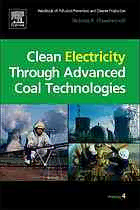
Clean electricity through advanced coal technologies PDF
Preview Clean electricity through advanced coal technologies
Handbook of Pollution Prevention and Cleaner Production Vol. 4 This page intentionally left blank Handbook of Pollution Prevention and Cleaner Production Vol. 4 Clean Electricity through Advanced Coal Technologies Nicholas P. Cheremisinoff AMSTERDAMlBOSTONlHEIDELBERGlLONDONlNEWYORKlOXFORD PARISlSANDIEGOlSANFRANCISCOlSINGAPORElSYDNEYlTOKYO WilliamAndrewisanimprintofElsevier WilliamAndrewisanimprintofElsevier TheBoulevard,LangfordLane,Kidlington,Oxford,OX51GB,UK 225WymanStreet,Waltham,MA02451,USA Firstpublished2012 Copyright(cid:1)2012ElsevierInc.Allrightsreserved. Nopartofthispublicationmaybereproducedortransmittedinanyformorbyanymeans,electronic ormechanical,includingphotocopying,recording,oranyinformationstorageandretrievalsystem, withoutpermissioninwritingfromthepublisher.Detailsonhowtoseekpermission,further informationaboutthePublisher’spermissionspoliciesandourarrangementwithorganizations suchastheCopyrightClearanceCenterandtheCopyrightLicensingAgency,canbefoundatour website:www.elsevier.com/permissions Thisbookandtheindividualcontributionscontainedinitareprotectedundercopyrightbythe Publisher(otherthanasmaybenotedherein). Notices Knowledgeandbestpracticeinthisfieldareconstantlychanging.Asnewresearchandexperience broadenourunderstanding,changesinresearchmethods,professionalpractices,ormedical treatmentmaybecomenecessary. Practitionersandresearchersmustalwaysrelyontheirownexperienceandknowledgeinevaluating andusinganyinformation,methods,compounds,orexperimentsdescribedherein.Inusingsuch informationormethodstheyshouldbemindfuloftheirownsafetyandthesafetyofothers,including partiesforwhomtheyhaveaprofessionalresponsibility. Tothefullestextentofthelaw,neitherthePublishernortheauthors,contributors,oreditors,assume anyliabilityforanyinjuryand/ordamagetopersonsorpropertyasamatterofproductsliability, negligenceorotherwise,orfromanyuseoroperationofanymethods,products,instructions,orideas containedinthematerialherein. BritishLibraryCataloguinginPublicationData AcataloguerecordforthisbookisavailablefromtheBritishLibrary LibraryofCongressControlNumber:2012936055 ISBN:978-1-4377-7815-1 ForinformationonallWilliamAndrewpublications visitourwebsiteatstore.elsevier.com PrintedandboundintheUnitedStates 12131415 10987654321 Contents Preface vii About the Author ix 1 AirPollution 1 1.1 Overview 1 1.2 The National EmissionsInventory 3 1.3 Criteria AirPollutants 3 1.3.1 Carbon Monoxide 4 1.3.2 Lead 4 1.3.3 Nitrogen Dioxide 5 1.3.4 Particulate Matter 6 1.3.5 Ozone 8 1.3.6 SulfurDioxide 9 1.3.7 NAAQS 10 1.4 Comparing Emissions 10 1.4.1 National Emissions Inventory 10 1.4.2 ToxicsRelea se Inventory 10 1.5 Mercury Releases 25 2 Solid Wastes 31 2.1 Overview 31 2.2 Coal CombustionByproducts 32 2.3 Regulations 37 2.4 Origins andGeneral Properties ofFlyAsh 39 2.5 Flue-GasDesulfurization Material 42 2.6 Toxic HeavyMetals Found inFly Ashes 43 2.7 Beneficial Ash Characteristics and Markets 43 2.8 RadioactiveConstituents 60 3 Old and New GenerationTechnologies 63 3.1 Overview 63 3.2 Stoker-Fired Coal Combustion 63 3.3 Pulverized-Coal Combustion 64 3.4 CycloneCoalCombustion 66 vi Contents 3.5 Fluidized-Bed Combustion 66 3.5.1 Pressurized Fluidized-Bed CombustionSystems 69 3.6 Gasification 70 3.7 Comparing EnergyCosts 79 4 CarbonCaptureand Sequestration 83 4.1 Introduction 83 4.2 FactorsInfluencing GHG Emissions 84 4.3 Emissions Trading Scheme 84 4.4 Carbon Capture andStorage (CCS)Technologies 87 4.4.1 Safety and EnvironmentalSetbacks 94 4.4.2 Recyclingand NewMarkets 96 4.5 Commercial Status 97 4.6 ImprovingEfficiencies 100 5 The TVAAsh Spill 109 5.1 Introduction 109 5.2 Facility Background 110 5.3 Coal Sources andQuantities 114 5.4 Solid Waste Storage 115 5.5 Ash Analysis 117 5.6 The Spill 117 5.7 Facility EnvironmentalFootprint 122 5.8 Airborne Releases fromthe SpillIncident 127 5.9 Exceedances andExcursions 134 5.10 Toxins Released 139 5.11 AnEstimate ofthe Releases to Air 140 5.12 Industry-Wide Problem 164 Recommended Sources 171 Glossary 177 Index 187 Preface The quality of life throughout mostof theworld is tied toelectricity. In this regard, coal plays a vital role in electricity generation worldwide. Coal-fired power plants currently fuel 41% of global electricity. In some countries, coal fuels a higher percentageofelectricity.Comparedtootherelectricity-generatingtechnologies,itis andislikelytoremainthemosteconomicalfuelsourcethroughthenextgeneration. Coal also carries with it the largest environmental footprint of all known power- producing technologies. Coal-fired power plants are the largest industry source of greenhousegases.Andthesolidwasteissuesthataretheresultofdependingonthis technologyarealmostmindboggling.IntheUnitedStatesalone,roughly1.05billion tonsofcoalareburnedeachyeartogenerateelectricity.Morethan500coal-burning plantsacrosstheUnitedStatesemit1.9billiontonsofcarbondioxideeachyearand create120milliontonsoftoxicwaste.Coalcombustionwaste(CCW)constitutesthe secondlargest waste stream after municipal solid waste inthe U.S. Sulfur dioxide scrubbers, which are used for air pollution controls, also create toxic waste. The flue-gas desulfurization (FGD) process creates a wet solid residue containingcalciumsulfite(CaSO )andcalciumsulfate(CaSO ).Drymaterialsuchas 3 4 fly ashis added tostabilize the slu dge for transportand landfill storage. Coal waste is disposed of in landfills generally referred to as ponds or surface impoundments.Thepondsarelinedwithcompactedclaysoil,aplasticsheet,orboth. When rain filters through the toxic ash pits, the toxic metals are leached out and pusheddownwardbygravitytowardtheliningandthesoilbelow.Becauseallliners eventually degrade, crack, or tear, landfills eventually leak and release their toxins into thegroundwater. The Environmental Protection Agencyhas reportedthat a 10- acrelandfillwouldleak0.2to10gallonsperday,orbetween730and36,500gallons overa10-yearperiod.Thereareanestimated156ashwastepondsacrosstheUnited Statescontainingmorethan19milliontonsoftoxicashwaste.In2008oneofthese waste ponds owned by the Tennessee Valley Authority failed, releasing 5.4 million cubicyards (4 million m3)into a community. Coalhasbeendubbedbymuchofthegeneralpublicas“dirtycoal.”Itisthecause ofmajorairpollution,globalwarming,andhasresultedinthereleaseoftoxicheavy metals and radionuclides, which place communities at long-term health risks. The coalindustrywasexemptfromreportingitsairemissionstothepublicuntilaboutthe turn ofthe twenty-firstcentury. This volume serves as primer on coal-burning technologies for electricity gener- ation. Newer generation technologies that are emerging and being commercialized viii Preface have significantly smaller environmental footprints than conventional technologies usedwiththeexistingcoal-firedinfrastructurethatcurrentlyexiststhroughoutmuch of the world. This volume is a part of the Cleaner Production series and meant to provide basic information and awareness of environmental issues and responsible pollutionmanagement. Theauthorextendsaheartfeltgratitudetothepublisherforitsfineproductionof this volume andseries. Nicholas P. Cheremisinoff, Ph.D. About the Author Nicholas P. Cheremisinoff has 30 years of international consulting and project management experience across a broad spectrum of industry sectors dealing with environmental management practices and technologies. His assignments have focusedoncorporateresponsiblecarethroughtheapplicationofpollutionprevention and cleaner production. He has served as both a practitioner and an educator to industry stakeholders on responsible care practices that strive to improve environ- mentalperformancethroughtheapplicationofcost-effectivecleantechnologies.He hasdesignedandimplementedprojectsfortheUnitedStatesAgencyforInternational Development,theWorldBankOrganization,theEuropeanUnion,theU.S.Tradeand Development Agency, the U.S. Department of Energy, the U.S. Department of Defense,andanumberofFortune100andmultinationalcompanies.Hehasapplied his experience and knowledge in major environmental toxic tort litigations as an expertwitnessinthefieldsofenvironmentalforensics,inhistoricalreconstructionof environmentalmanagementpractices,andinformulatingopinionsregardinglevelsof responsible care exercised by industry stakeholders. He is the author, coauthor, or editor of more than 160 book publications and numerous state-of-the-art review articlesandR&Dpapers.Herecei vedhisB.S.,M.S.,andPh.D.degreesinchemical engineeringfrom Clarkson Collegeof Technology.
